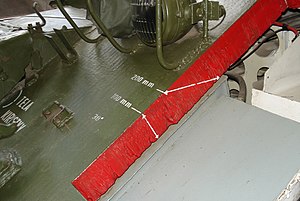
Back Maili zireh Azerbaijani Blindage incliné French Corazza inclinata Italian 避弾経始 Japanese Рациональное бронирование Russian Sluttande pansar Swedish Eğimli zırh Turkish Раціональне бронювання Ukrainian

Sloped armour is armour that is oriented neither vertically nor horizontally. Such angled armour is typically mounted on tanks and other armoured fighting vehicles (AFVs), as well as naval vessels such as battleships and cruisers. Sloping an armour plate makes it more difficult to penetrate by anti-tank weapons, such as armour-piercing shells, kinetic energy penetrators and rockets, if they follow a more or less horizontal trajectory to their target, as is often the case. The improved protection is caused by three main effects.
Firstly, a projectile hitting a plate at an angle other than 90° has to move through a greater thickness of armour, compared to hitting the same plate at a right-angle. In the latter case only the plate thickness (the normal to the surface of the armour) must be pierced. Increasing the armour slope improves, for a given plate thickness, the level of protection at the point of impact by increasing the thickness measured in the horizontal plane, the angle of attack of the projectile. The protection of an area, instead of just a single point, is indicated by the average horizontal thickness, which is identical to the area density (in this case relative to the horizontal): the relative armour mass used to protect that area.
If the horizontal thickness is increased by increasing the slope while keeping the plate thickness constant, a longer and thus heavier armour plate is required to protect a certain area. This improvement in protection is simply equivalent to the increase of area density and thus mass, and can offer no weight benefit. Therefore, in armoured vehicle design the two other main effects of sloping have been the motive to apply sloped armour.
One of these is the more efficient envelopment of a certain vehicle volume by armour. In general, more rounded shapes have a smaller surface area relative to their volume. In an armoured vehicle that surface must be covered by heavy armour, so a more efficient shape leads to either a substantial weight reduction or a thicker armour for the same weight. Sloping the armour leads to a better approximation of the ideal rounded shape.
The final effect is that of deflection, deforming and ricochet of a projectile. When it hits a plate under a steep angle, its path might be curved, causing it to move through more armour – or it might bounce off entirely. Also it can be bent, reducing its penetration. Shaped charge warheads may fail to penetrate or even detonate when striking armour at a highly oblique angle. However, these desired effects are critically dependent on the precise armour materials used in relation to the characteristics of the projectile hitting it: sloping might even lead to better penetration.
The sharpest angles are usually designed on the frontal glacis plate, because it is the hull direction most likely to be hit while facing an attack, and also because there is more room to slope in the longitudinal direction of the vehicle.
© MMXXIII Rich X Search. We shall prevail. All rights reserved. Rich X Search